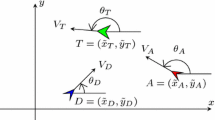Abstract
Capture conditions in a planar pursuit-evasion game between a guided missile and its aerial target, each having either forward control or tail control, are derived analytically. The adversaries closed-loop maneuver dynamics are represented by first-order biproper transfer functions. A distinction is made between open and closed capture zones in the reduced-order game space. It is shown that locating the control surface forward, instead of aft, provides considerable advantages with regard to the existence and size of different capture zones. A new game space decomposition with two singular regions is also presented and the conditions for its existence are given.
Similar content being viewed by others
Reference
A.E. Bryson Y.C. Ho (1969) Applied Optimal Control Blaisdell Publishing Company Waltham, Massachusetts 154–155
V. Garber (1968) ArticleTitleOptimum Intercept Laws for Accelerating Targets AIAA Journal 6 IssueID11 2196–2198
R.G. Cottrell (1971) ArticleTitleOptimum Intercept Guidance for Short-Range Tactical Missiles AIAA Journal 9 IssueID7 1414–1415
R. Isaacs (1965) Differential Games Wiley New York, NY
S. Gutman G. Leitmann (1976) ArticleTitleOptimal Strategies in the Neighborhood of a Collision Course AIAA Journal 14 IssueID9 1210–1212
S. Gutman (1979) ArticleTitleOn Optimal Guidance for Homing Missiles AIAA Journal of Guidance and Control 3 IssueID4 296–300
Shinar J., (1981). Solution Techniques for Realistic Pursuit – Evasion Games, Advances in Control and Dynamic Systems. Academic Press, New York, NY, 17, 63–124.
V. Turetsky J. Shinar (2003) ArticleTitleMissile Guidance Laws Based on Pursuit-Evasion Game Formulations Automatica 39 IssueID4 607–618 Occurrence Handle10.1016/S0005-1098(02)00273-X Occurrence HandleMR2138147
S. Gutman (2003) ArticleTitleSuperiority of Canards in Homing Missiles IEEE Transactions on Aerospace and Electronic Systems 39 IssueID3 740–746 Occurrence Handle10.1109/TAES.2003.1238732
T. Shima J. Shinar (2002) ArticleTitleTime-Varying Pursuit-Evasion Game Models with Bounded Controls AIAA Journal of Guidance, Control, and Dynamics 25 IssueID3 425–432
Author information
Authors and Affiliations
Additional information
J. Shinar
The author expresses his gratitude to the anonymous reviewers for the thorough reading of the paper and helpful comments.
Rights and permissions
About this article
Cite this article
Shima, T. Capture Conditions in a Pursuit-Evasion Game between Players with Biproper Dynamics1. J Optim Theory Appl 126, 503–528 (2005). https://doi.org/10.1007/s10957-005-5495-3
Issue Date:
DOI: https://doi.org/10.1007/s10957-005-5495-3




